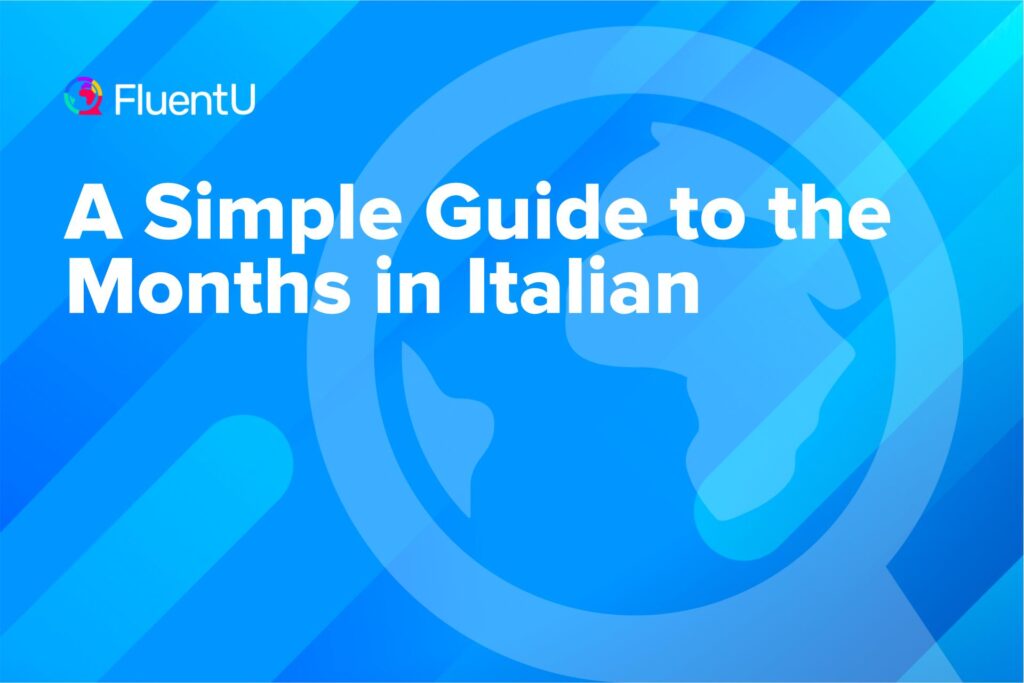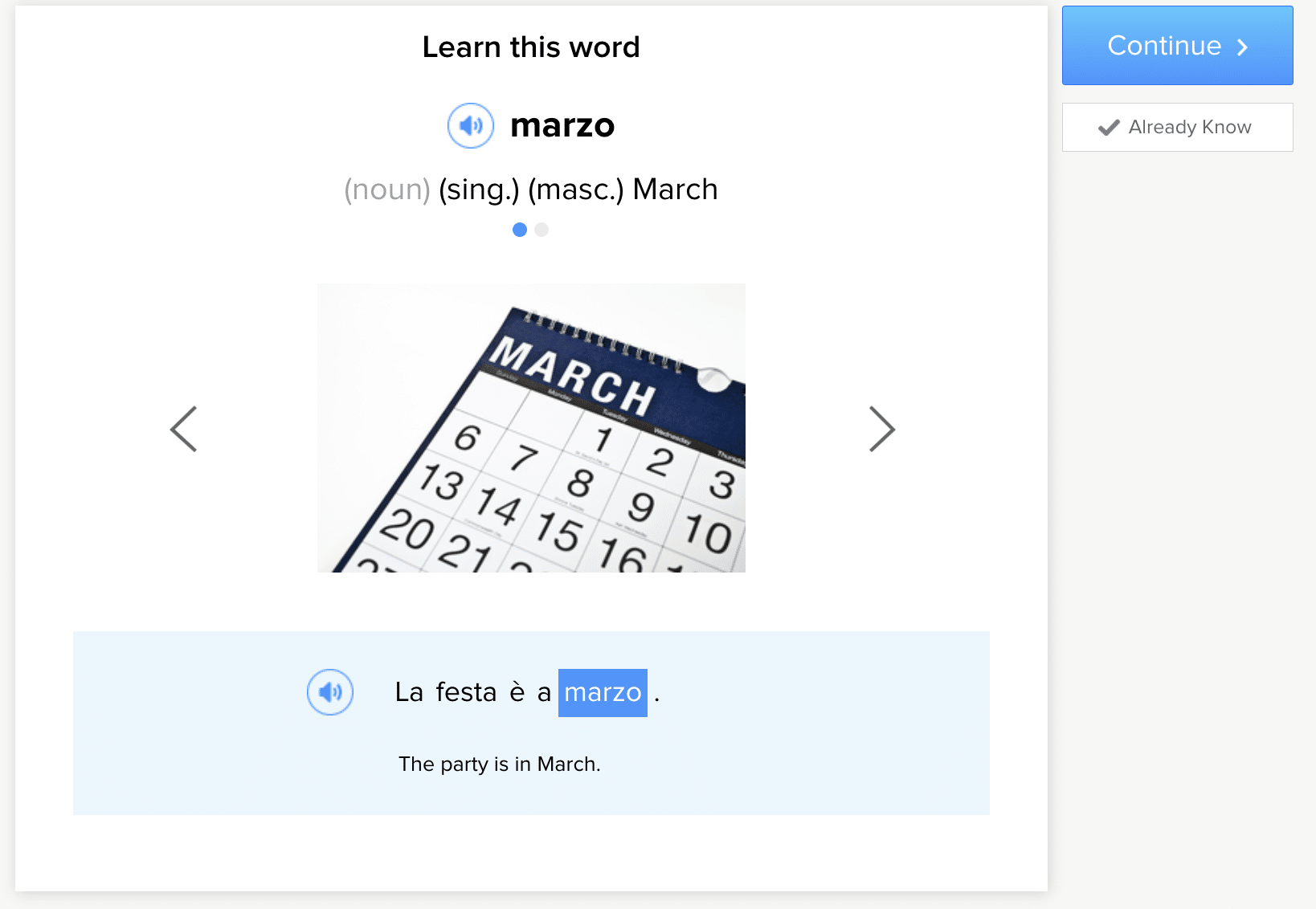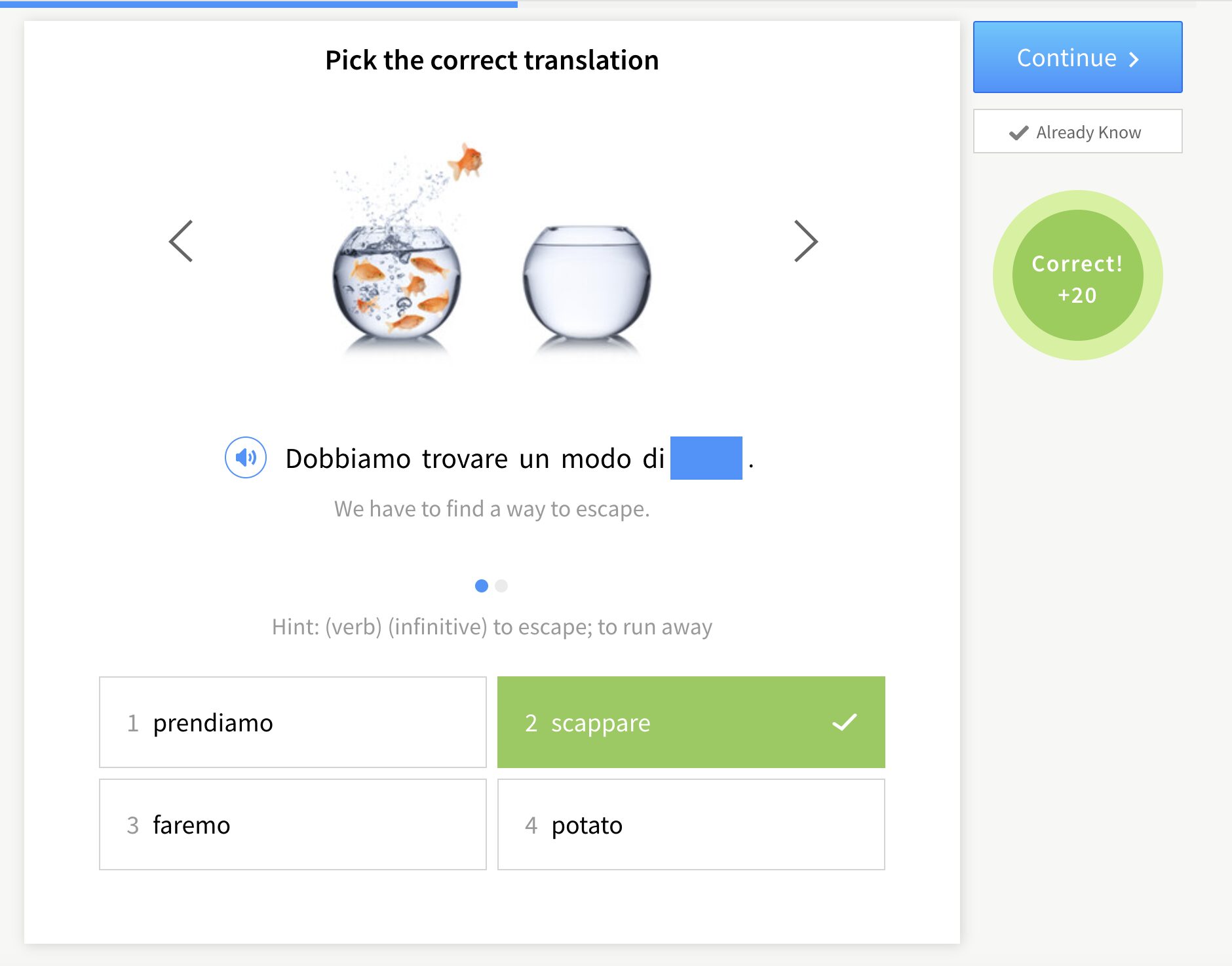A Simple Guide to the Months in Italian

The word for “months” in Italian is mesi (or mese if you’re talking about only one month).
Note that the names of the months are not capitalized in Italian. Read on for in-depth information about each month, including the culture and traditions surrounding them. I’ll also give you some tips for using the months in sentences, discussing calendar time and using an Italian calendar.
Download: This blog post is available as a convenient and portable PDF that you can take anywhere. Click here to get a copy. (Download)
The 12 Months of the Year in Italian
Did you know that March is crazy and a windy June brings wheat to the farmyard?
Italian is full of countless seasonal proverbs like those. Each month carries important cultural weight, especially when deciding what to eat!
Here’s a quick list of all 12 months and how to say them in Italian:
| January | gennaio | jehn-nah-yoh |
| February | febbraio | fehb-brah-yoh |
| March | marzo | mar-tsoh |
| April | aprile | ah-pree-leh |
| May | maggio | mahd-joh |
| June | giugno | joo-nyoh |
| July | luglio | loo-lyoh |
| August | agosto | ah-goh-stoh |
| September | settembre | seht-tehm-breh |
| October | ottobre | oht-toh-breh |
| November | novembre | noh-vehm-breh |
| December | dicembre | dee-chem-breh |
Below, I’ll tell you all about the national feasts and holidays that occur throughout the year in Italy. Learning cultural associations for each month can help you remember which is which.
Gennaio (January)
Season: Winter
Origin: All of the Italian month names come from their Latin equivalents. Gennaio comes from the Latin word for the first month of the year, Januarius, which is based on the Greek god Janus
Capodanno (New Year’s Day) is a major Italian holiday. On this day, Italians eat lentils and wear red underwear for good luck. Throughout January, Italians greet each other with a spirited “Auguri,” which means “best wishes.”
Children across Italy also look forward to a visit from La Befana in January. According to Italian folklore, La Befana is an old witch who visits all Italian children on the Eve of Epiphany (January 5). If the child has been good, they receive candy in their stocking. If they’ve been bad, La Befana leaves them coal.
Febbraio (February)
Season: Winter
Origin: Febbraio can be traced back to the Latin Februarius and the Roman festival Februa, which focused on purification.
Carnevale—the national carnival festival that culminates with Martedì Grasso (Fat Tuesday)—is the highlight of February in Italy.
Children dress up in costumes, and in Venice adults dress up in elaborate ball gowns and masks. Southern Italians eat rich lasagnas and chocolate pig’s blood pudding on Fat Tuesday before settling into the 40 days of Lent.
Marzo (March)
Season: Spring
Origin: Marzo is from the Latin Martius, which is named after Mars, the Roman god of war.
“Marzo è pazzo!” (March is crazy), most Italians will eagerly tell you.
The weather is blustery, spring never seems to arrive and the Ides of March (March 15) marks the day Julius Caesar was assassinated.
One bright spot is that seasonal produce—including fava beans and wild asparagus—arrives in the fresh open markets of Italian piazzas, revealing that spring is not so far away after all.
Italians celebrate La Festa del Papà (Father’s Day) on the Feast of Saint Joseph (March 19) with a special fritter called zeppole di San Giuseppe (Saint Joseph fritter).
Aprile (April)
Season: Spring
Origin: Aprile is taken from the Latin Aprilis. It might be related to the Latin word aperire meaning to open—like how flowers and trees blossom during this month.
The first day of April in Italy is called Pesce d’aprile (April Fish) and is similar to April Fool’s Day. After telling a wild joke or fib, Italians then shout, “Pesce d’aprile!” and present you with a plastic fish.
The highlight of April for most Italians is Easter.
Pasqua (Easter) means a lot of eating in Italy. Traditionally, Italians eat ricotta salata (sheep’s milk ricotta) and roasted lamb for Easter. In Naples and on the Amalfi Coast, a special dessert known as pastiera, consisting of grain, ricotta, egg and citrus essence is a sign of fertility and new life.
The day after Easter in Italy is the beloved Pasquetta (Easter Monday), when the entire country takes to the countryside for grand multi-course picnics, whether rain or shine!
Maggio (May)
Season: Spring
Origin: Maggio has its roots in the Latin word Maius. This is named in honor of the earth goddess Maia.
May 1 in Italy is a national holiday called Festa dei lavoratori (Workers’ Day). Parades, demonstrations and free concerts occur across the country.
By now, many will begin eating cozze (mussels) again. According to local beliefs, you can’t eat mussels in months that have an r in them. May, therefore, means more mussels.
Giugno (June)
Season: Summer
Origin: Giugno comes from the Latin Junius. This is thought to be named after either Juno, the Roman goddess of marriage, or Lucius Brutus, the founder of the Roman Republic.
By giugno (June), Italian children are out of school and ready for estate (summer). Thus begins the national obsession with going to the beach to enjoy a bagno (swim).
Yet farmers might welcome rainy weather. A centuries-old proverb advises, “giugno tonante, raccolto abbondante” (thundering June, abundant harvest).
The summer solstice is on June 21, leading many Italians to call June the mese del sole (month of the sun).
Luglio (July)
Season: Summer
Origin: Luglio comes from the Latin Julius. It’s based on Julius Caesar, the famous Roman military general and politician, since he was born in July!
Italians say, “se piove tra luglio e agosto, piove miele, olio e mosto” (if it rains between July and August, it rains honey, oil and wine must).
Since it’s humid during this time across most of the Italian peninsula, many locals complain, “fa caldissimo!” (it’s so hot). The burst of July rains not only provides cool relief, but also improves the olive and grape harvests coming in the fall.
Agosto (August)
Season: Summer
Origin: Agosto is based on the Latin Agustus. This is named after another popular historical figure—Augustus or Octavian, the first emperor of the Roman Empire.
The most important summer holiday in Italy is Ferragosto on August 15.
On this Catholic holiday, Italians celebrate the Feast of the Assumption of the Virgin Mary. This means big family meals and fireworks. Nearly the entire country flocks to the beach in August, and most local businesses in major urban centers close.
Settembre (September)
Season: Autumn
Origin: Settembre is named after the Latin September. This comes from septem, meaning seven. In the ancient Roman calendar, the year started in March, making September the seventh month.
September brings the tomato harvest across most of Southern Italy. During this time, families can and preserve thousands of tomatoes to last the whole year.
Children go back to school in mid-September, completing the national ritual of the rientro (return), which represents the end of summer.
Ottobre (October)
Season: Autumn
Origin: Ottobre follows from the Latin word October, with octo meaning eight. Similar to Settembre, this is because October is the eighth month in the ancient Roman calendar.
Many Italians retreat to the mountains in the month of October, where they forage for wild castagna (chestnuts) and funghi (mushroom).
This is also the time of the vendemmia (grape harvest).
The popular Festa di San Francesco d’Assisi (Feast of Saint Francis of Assisi) is celebrated on October 4, with many pilgrims flocking to the Basilica of Assisi.
Novembre (November)
Season: Autumn
Origin: Novembre comes directly from the Latin November. Novem is the Latin word for nine.
The Festa dei morti (All Soul’s Day) is on November 2 in Italy. On this day, Italians visit the graves of deceased loved ones and light red votives to commemorate the dead.
By November, autunno (fall) is in full swing. The Festa di San Martino (Feast of Saint Martin) on November 11 is an exciting day, with vintners opening their first vini novelli (young wines) of the season.
Dicembre (December)
Season: Winter
Origin: Dicembre is taken from the Latin December, where decem means ten.
And thus begins the merry season of Natale (Christmas).
Families display intricate presepe (nativity crèches) and wait until midnight of December 24 to place Baby Jesus in his manger.
December in Italy is also known for family time. And in Southern Italy, Italians celebrate the Vigilia (Christmas Eve) with a feast of fish.
How to Use Months in Italian
Now that you know about the names of the months in Italian, let’s look at how they work in actual sentences:
Gender
In Italian, all of the months (i mesi) are masculine.
This means that when you’re talking about months, you have to match them with masculine pronouns and adjectives:
Ho amato marzo; è stato bellissimo. (I loved March; it was beautiful.)
Quest’anno abbiamo avuto un gennaio freddo. (This year we had a cold January.)
Articles
While months in Italian are masculine, you’ll notice that you usually don’t have to add il before the month. For example, you’ll usually just say Gennaio instead of Il Gennaio
Sometimes you can add il, though, for describing a specific date, such as il 15 marzo (the 15th of March).
Prepositions
One of the most common prepositions for months is a (in/on):
A novembre, festeggiamo il suo compleanno. (In November, we celebrate his/her birthday.)
There’s also in (in), which means an event happens for the whole month:
In giugno, iniziano le vacanze estive per gli studenti. (In June, the summer holidays begin for students.)
Other prepositions include da… a (from… to) and entre (by).
Capitalization
Unlike in English, Italian months are considered common nouns, so they’re not capitalized. You’ll only capitalize them if they’re at the start of a sentence or in a title:
Luglio e agosto sono i mesi più caldi in Italia. (July and August are the hottest months in Italy.)
Abbreviations
Abbreviations for Italian months are pretty straightforward. Just take the first three letters of the month:
| Italian Month | Abbreviation | English |
|---|---|---|
| gennaio | gen. | January |
| febbraio | feb. | February |
| marzo | mar. | March |
| aprile | apr. | April |
| maggio | mag. | May |
| giugno | giu. | June |
| luglio | lug. | July |
| agosto | ago. | August |
| settembre | set. | September |
| ottobre | ott. | October |
| novembre | nov. | November |
| dicembre | dic. | December |
Example Sentences with Italian Months
To get the hang of it, check out these example sentences that cover each month in Italian:
- A gennaio, vado sempre in montagna a sciare. (In January, I always go to the mountains to ski.)
- Febbraio è noto per essere il mese dell’amore per via di San Valentino. (February is known as the month of love because of Valentine’s Day.)
- A marzo, i fiori iniziano a sbocciare segnando l’inizio della primavera. (In March, the flowers start to bloom, marking the beginning of spring.)
- Ad aprile, solitamente iniziamo a organizzare cene in terrazza con la famiglia. (In April, we usually start organizing terrace dinners with the family.)
- Mia sorella si sposa a maggio, sarà un gran mese! (My sister is getting married in May, it’s going to be a big month!)
- Non vedo l’ora che giugno arrivi, perché prenderò delle lunghe vacanze. (I can’t wait for June to arrive because I’ll be taking a long vacation.)
- Ogni luglio, la città ospita un festival di musica jazz molto popolare. (Every July, the city hosts a very popular jazz music festival.)
- Verso la fine di agosto, iniziamo a prepararci per il ritorno a scuola. (Towards the end of August, we start preparing for the return to school.)
- Settembre è il mese in cui inizia la vendemmia nelle regioni vinicole italiane. (September is the month when the grape harvest begins in the Italian wine regions.)
- Il clima di ottobre è perfetto per lunghe camminate all’aperto. (The October weather is perfect for long walks outdoors.)
- Verso metà novembre, iniziamo già a pensare dove comprare i regali di Natale. (By mid-November, we’re already thinking about where to buy Christmas gifts.)
- Ogni dicembre, mi prendo un momento per riflettere sull’anno trascorso e pianificare il prossimo anno. (Every December, I take a moment to reflect on the past year and plan for the coming year.)
Common Expressions that Use Months in Italian
The Italian language has plenty of expressions and sayings that feature specific months, and there’s usually some connection with agriculture or nature:
- Bello di Gennaio, spesso brutto di Febbraio. (If January is nice, February will likely be awful.)
- Marzo pazzerello, esce il sole e prendi l’ombrello. (Crazy March, the sun comes out and you take the umbrella.)
- Aprile piovoso, maggio ventoso, anno fruttuoso. (A rainy April and windy May make a fruitful year.)
- Finchè giugno non è all’otto, non ti togliere il cappotto. (Until June 8th, don’t take off your coat.)
- Luglio giostra l’uva, i fichi e la fortuna nostra. (July juggles the grapes, the figs and our fortune.)
- Agosto prepara la cucina, a settembre la cantina. (August prepares the larder, September the wine cellar.)
- In settembre, la notte al dì contende. (In September, the night competes with the day.)
- Ottobre è bello, ma tieni pronto l’ombrello. (October is nice, but keep the umbrella ready.)
- Se di novembre non avrai arato tutto l’anno sarà tribolato. (If you haven’t plowed by November, the whole year will be troubled.)
- Dicembre gelato, non va disprezzato.(A frosty December should not be scorned.)
More Calendar Vocabulary
Aside from describing months in Italian, you’ll also need other useful vocabulary for talking about calendar time, such as the words for the seasons. Here’s a handy reference including the seasons in Italian and much more.
| day/days | giorno / giorni | johr-noh / johr-nee |
| today | oggi | awh-jee |
| tomorrow | domani | doh-mah-nee |
| yesterday | ieri | ee-yeh-ree |
| week/weeks | settimana / settimane | sett-ee-mah-nah / sett-ee-mah-neh |
| this week | questa settimana | kwest-ah sett-ee-mah-nah |
| next week | la prossima settimana | lah pross-see-mah sett-ee-mah-nah |
| last week | la settimana scorsa | lah sett-ee-mah-nah skor-sah |
| weekend | fine settimana | fee-ne set-ti-mah-nah |
| month/months | mese / mesi | meh-zeh / meh-zee |
| this month | questo mese | kwest-oh meh-zeh |
| next month | il prossimo mese | ihl pross-see-moh meh-zeh |
| last month | lo scorso mese | loh skor-soh meh-zeh |
| year/years | anno / anni | ahn-noh / ahn-nee |
| this year | quest'anno | kwest-ahn-noh |
| next year | l'anno prossimo | lahn-noh pross-see-moh |
| last year | l'anno scorso | lahn-noh skor-soh |
| season/seasons | stagione / stagioni | stah-jee-oh-neh / stah-jee-oh-nee |
| spring | primavera | pree-mah-veh-rah |
| summer | estate | eh-stah-teh |
| autumn | autunno | ah-ooh-toon-noh |
| winter | inverno | een-ver-noh |
| calendar | calendario | kal-lehn-dah-ree-oh |
| schedule | orario | oh-rah-ree-oh |
| date | date | dah-tah |
| holiday (festivity) | festività | fest-ee-vee-tah |
| holiday (holy day) | giorno festivo | jeor-noh fes-tee-voh |
| vacation | ferie | feh-ree-eh |
Be sure to notice which words are masculine or feminine as you practice.
How to Learn the Months in Italian
Review with flashcards
If you want a quick way to remember the months in Italian, you can make flashcards and then review them using spaced repetition.
Spaced repetition is a handy technique that’s often used in language learning. You start out with reviewing a card daily, and then every few days, every week and so on, with the time interval increasing until the card becomes part of your long-term memory.
You can try this out for any vocabulary, especially time-related ones such as months and seasons (which can be tricky to remember all at once)! One resource for this is the FluentU Italian program.
FluentU takes authentic videos—like music videos, movie trailers, news and inspiring talks—and turns them into personalized language learning lessons.
You can try FluentU for free for 2 weeks. Check out the website or download the iOS app or Android app.
P.S. Click here to take advantage of our current sale! (Expires at the end of this month.)
FluentU can instantly generate Italian flashcards for you—just type in the Italian word, and you’ll get a flashcard that includes the pronunciation, meaning, example sentences and even video clips that use that word.
In fact, it has a flashcard deck already for the months of the year:

It also schedules regular reviews for you, and it features hundreds of authentic Italian videos that teach essential vocabulary, with personalized quizzes included.
Sing along to popular songs
Many school-aged children learn catchy songs to memorize the months in Italian and to remember which months contain 30 days. As you start learning Italian, children’s didactic material can be really helpful.
Do you remember the childhood song that begins: 30 days hath September, April, June and November…? The same song exists in Italian!
Listening to the popular children’s song “I Mesi Dell’anno” (The Months of the Year) is another easy way to practice saying each month in Italian:
If you want to give your listening skills a test, there’s also a version without subtitles.
As you advance, listening to more age-appropriate songs will provide suitable practice. Try listening to the following Italian songs that feature months of the year:
- The rendition of “La pioggia di marzo” (The Waters of March) from pop singer Mina
- The hit song “Nove Maggio” (May 9) by Neapolitan rapper Liberato
- The ballad “Agosto” (August) from indie-rock band “Perturbazione”
How to Use an Italian Calendar
There are two kinds of calendars in Italian culture: the regular Gregorian calendar and the Saint Day calendar.
Both follow the same months and days of the year, but the Saint Day calendar lists the names of saints for each day. The good news is, both are beneficial for learning the months in Italian!
Regular calendar
Download and print an Italian calendar to practice saying the date every morning. As you can imagine, knowing the numbers in Italian is important for formulating dates.
To say the date in Italian, follow this simple formula:
Oggi è (today is) number + month.
For example, oggi è il 27 marzo (today is March 27).
There are two important things to note:
- First, the date always comes before the month in Italian.
- Second, you don’t capitalize the months in Italian.
For the first day of the month, you use the ordinal number for one: primo. For example, oggi è il primo marzo (today is the first of March).
Saint Day calendar
A Saint Day calendar can also be a fun way to practice months in Italian. In Italy (and across the Roman Catholic world), each day has an associated saint.
These calendars are culturally important in Italy because people celebrate their name days. Since each saint has a specific day, your birthday also belongs to a saint. The Saint Day that’s also your birthday is known as your “name day.”
In Italian, this is called an onomastico (name day). For example, if your name is Anthony (or Antonio), you celebrate your name day on 13 giugno (June 13).
You would say:
Il mio onomastico è il 13 giugno (My name day is June 13).
Practice the months in Italian by consulting the Saint Day calendar and discover which saint shares your birthday (and your friends’)!
Now that you’ve learned the mesi (months) and stagioni (seasons) in Italian, it’s time to truly experience them. The best way to start is to practice daily. Don’t be afraid to talk to yourself and use free language apps online.
Before you know it, you’ll be experiencing each month of the year as if you were already in bella Italia!
Download: This blog post is available as a convenient and portable PDF that you can take anywhere. Click here to get a copy. (Download)
And One More Thing…
If you’re like me and prefer learning Italian on your own time, from the comfort of your smart device, I’ve got something you’ll love.
With FluentU’s Chrome Extension, you can turn any YouTube or Netflix video with subtitles into an interactive language lesson. That means you can learn Italian from real-world content, just as native speakers actually use it.
You can even import your favorite YouTube videos into your FluentU account. If you’re not sure where to start, check out our curated library of videos that are handpicked for beginners and intermediate learners, as you can see here:
FluentU brings native Italian videos within reach. With interactive captions, you can hover over any word to see its meaning along with an image, audio pronunciation, and grammatical information.
Click on a word to see example sentences and other videos where it's used in different contexts, then add it to your flashcards. For example, if I tap on the word "scappare," this is what pops up:
Want to make sure you remember what you've learned? We’ve got you covered. Each video comes with exercises to review and reinforce key vocab. You’ll get extra practice with tricky words and be reminded when it’s time to review so nothing slips through the cracks.
The best part? FluentU tracks everything you’re learning and uses that to create a personalized experience just for you. Start using the FluentU website on your computer or tablet or, better yet, download our app from the App Store or Google Play.
Click here to take advantage of our current sale! (Expires at the end of this month.)












